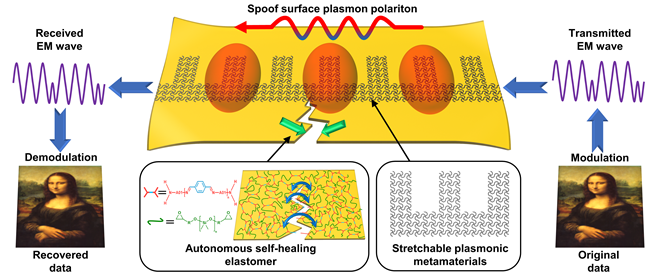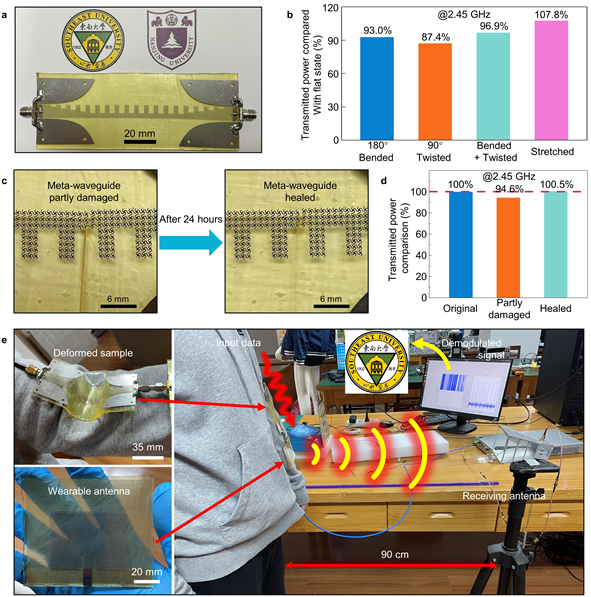In 2022, the Flexible Radio Frequency Technology Research Center of Southeast University published a paper entitled " Stretchable and self-healable spoof plasmonic meta-waveguide for wearable wireless communication system " in the top international academic journal Light: Science & Applications (a Nature sub-journal, a top journal in the first quartile of the Chinese Academy of Sciences, with an impact factor of 20.257). The following is a detailed introduction.
Flexible radio frequency technology is a cutting-edge technology that has developed rapidly in recent years and has important application prospects in fields such as flexible wearable devices and humanoid robots.
As the most fundamental component of flexible radio frequency (RF) systems, the performance of flexible planar microwave transmission lines is highly sensitive to structural changes. Even slight structural deformation can lead to a sharp decline in their electromagnetic performance, severely impacting RF signal transmission. However, wearable flexible devices inevitably endure prolonged bending and twisting, and damage or deformation of the flexible planar microwave transmission lines poses a significant threat to the stability of the entire wearable system. Therefore, ensuring stable and reliable RF signal transmission in flexible wearable systems is one of the major challenges that urgently needs to be addressed in the field of flexible RF technology.
Recently, Professor Weibing Lu's team at the Flexible Radio Frequency Technology Research Center of Southeast University, in collaboration with Academician Quan Li's team from the Institute of Intelligent Materials and the School of Chemistry and Chemical Engineering, and Professor Chenghui Li's team from the State Key Laboratory of Coordination Chemistry at Nanjing University, has made significant progress in self-healing flexible microwave waveguides. They proposed and realized a novel flexible stretchable microwave waveguide with excellent stability and room-temperature self-healing capabilities, providing a new approach for the design and fabrication of future flexible wearable radio frequency devices and systems.
该成果以“Stretchable and self-healable spoof plasmonic meta-waveguide for wearable wireless communication system”为题发表在Light: Science & Applications。This research, titled " Stretchable and self-healable spoof plasmonic meta-waveguide for wearable wireless communication system" was published in Light: Science & Applications. The corresponding authors are Professor Weibing Lu and Academician Quan Li of Southeast University, and Professor Chenghui Li of Nanjing University. The first author is Buyun Yu, a doctoral student at Southeast University, and Dewei Le, a master's student at Nanjing University, is a co-first author. Other contributors include Kexin Hou, a doctoral student at Nanjing University; Lu Ju, a doctoral student; Hao Chen, a postdoctoral fellow; Cong Ding, a master's student at Southeast University; Professor Yingshi Guan; Professor Zhenguo Liu; and Professor Yunqian Dai. This work was supported by the National Natural Science Foundation of China (NSFC) Outstanding Youth Science Fund and General Program, the Fundamental Research Funds for the Central Government Frontier Science Center, the Jiangsu Provincial Innovation and Entrepreneurship Team, the Jiangsu Distinguished Professor Program, and the Purple Mountain Laboratories.
Figure 1 illustrates a novel waveguide correlation mechanism based on self-healing elastomers and stretchable artificial surface plasmonic metamaterials. The research team designed an elastomer substrate with high strength, good flexibility, and room-temperature self-healing capability based on dynamic imine bonds. Unlike other linear self-healing materials, this substrate exhibits low creep due to its dynamic three-dimensional cross-linked network structure, thus ensuring the long-term stability of the RF device morphology. When the substrate is completely cut at room temperature and the cut surfaces are then rejoined, it can recover its original mechanical strength within 24 hours. Furthermore, the presence of epoxy groups provides excellent adhesion between the substrate and the metal structure surface, greatly facilitating device fabrication and assembly.

Figure 1. Schematic diagram of a self-healing flexible stretchable artificial surface plasmon waveguide
In practical applications, a dynamically changing elastic substrate after damage may not achieve a perfectly smooth crack repair, and the self-healing process itself requires a certain amount of time. To maintain wireless communication quality at all times, the RF device structure itself needs to possess damage and deformation resistance. To this end, the research team proposed a novel artificial surface plasmon waveguide structure based on a stretchable serpentine metal structure. This waveguide structure exhibits excellent tensile and torsional properties without sacrificing electromagnetic performance. Compared with traditional planar microwave transmission lines, thanks to the unique field distribution of artificial surface plasmons, this waveguide has a higher tolerance to damage and deformation of the metal structure and substrate. The self-healing material can repair damage in real time and maintain the mechanical strength of the device structure, while the artificial surface plasmon structure can maintain good electromagnetic performance under damage and deformation. The characteristics of the two complement each other, thus realizing a novel microwave waveguide with excellent stability and durability.
As a functional verification, the research team fabricated a self-healing flexible stretchable artificial surface plasmonic waveguide and conducted corresponding tests (Figure 2).

Figure 2. Self-healing flexible stretchable artificial surface plasmon waveguide and performance testing
Test results demonstrate that even with structural damage, bending, and twisting, the novel waveguide maintains reliable electromagnetic wave transmission, and its transmission performance almost fully recovers to its initial state after self-repair. Simultaneously, a human network test environment was constructed using software-defined radio to simulate a flexible wearable electronic system. In the experiment, the waveguide was placed on the elbow and connected to the transmitter of the software-defined radio system. Electromagnetic waves were transmitted externally via the wearable antenna after passing through the waveguide device on the elbow, and were ultimately received and restored by the software-defined radio system. The experiment shows that elbow movement does not cause signal distortion. Regardless of whether the waveguide device on the elbow is bent, twisted, or suffers structural damage, the wireless communication quality is not significantly affected. The experimental results demonstrate the excellent stability and durability of the self-healing flexible stretchable artificial surface plasmonic waveguide.
Paper Information
Yu, BY., Yue, DW., Hou, KX. et al. Stretchable and self-healable spoof plasmonic meta-waveguide for wearable wireless communication system. Light Sci Appl 11, 307 (2022).
https://doi.org/10.1038/s41377-022-01005-1



 京公网安备 11010802027423号
京公网安备 11010802027423号